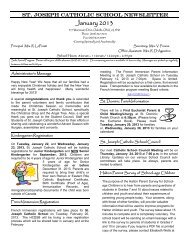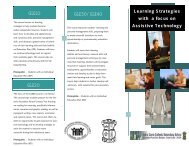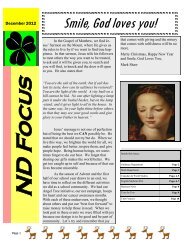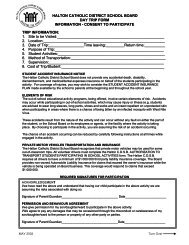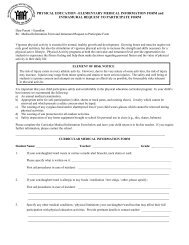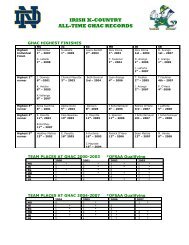Daily Physical Activity in Schools
Daily Physical Activity in Schools
Daily Physical Activity in Schools
Create successful ePaper yourself
Turn your PDF publications into a flip-book with our unique Google optimized e-Paper software.
<strong>Daily</strong> <strong>Physical</strong> <strong>Activity</strong> <strong>in</strong> <strong>Schools</strong> | Sample Activities for Students<br />
Clothes-Peg<br />
Tag<br />
Time<br />
20 m<strong>in</strong>utes<br />
Facility<br />
❏ Classroom ❏ Multipurpose<br />
✓❏ Gymnasium ✓ ❏ Outdoors<br />
Equipment<br />
50–75 clothes pegs<br />
Safety<br />
<strong>Physical</strong> <strong>Activity</strong> Level<br />
✓❏ Moderate ✓ ❏ Vigorous<br />
Rem<strong>in</strong>d students to be cautious when mov<strong>in</strong>g and to be aware of the personal space of others.<br />
Warm-up<br />
Have students work <strong>in</strong> groups of 3–5 and l<strong>in</strong>e up one beh<strong>in</strong>d the other.<br />
Have the first student lead the group around the activity area us<strong>in</strong>g a variety of movements.<br />
Every 30 seconds, have students change leaders and <strong>in</strong>crease their speed (e.g., slow walk, walk, speed walk, jog).<br />
Lead, or have a student lead, a stretch<strong>in</strong>g rout<strong>in</strong>e (see the Appendix for sample stretches).<br />
<strong>Activity</strong> 1: Atom<br />
Have students travel around the activity area.<br />
Call out a number every 45 to 60 seconds, and have students form a group of that number. Students do a physical activity (e.g., jogg<strong>in</strong>g on<br />
the spot, stride jumps). If there is an extra student, the group can make the formation or circle around that student.<br />
Call out another number to cont<strong>in</strong>ue the game.<br />
<strong>Activity</strong> 2: Clothes-Peg Tag (Adapted from: CIRA Ontario, You’re “It”! Tag, Tag . . . and More Tag, 2001)<br />
Have each student attach three clothes pegs to the hem on the back of his or her shirt.<br />
Have students play the follow<strong>in</strong>g variant of the game of tag, <strong>in</strong> which everyone is “it” at the same time.The object of the game is to take as<br />
many clothes pegs off the back of other students’ shirts as possible. Students attach the clothes pegs they have taken to the hem on the front of<br />
their own shirts. Once a clothes peg is on the front of a shirt, it cannot be taken. At the beg<strong>in</strong>n<strong>in</strong>g of each game, have the students redistribute<br />
the clothes pegs so everyone starts with the same number.<br />
Game 1: Offence Rules. At the end of the game, the students receive one po<strong>in</strong>t for all clothes pegs on the back of their shirts and 10 po<strong>in</strong>ts<br />
for all the clothes pegs on the front.<br />
Game 2: Defence Time. At the end of the game, the students receive one po<strong>in</strong>t for all clothes pegs on the front of their shirts and 10 po<strong>in</strong>ts<br />
for all the clothes pegs on the back.<br />
Game 3: Your Choice. At the end of the game, the students receive five po<strong>in</strong>ts for all clothes pegs on the front of their shirts and five po<strong>in</strong>ts<br />
for all the clothes pegs on the back.<br />
Game 4: Small-Group Tag. Students play the same game <strong>in</strong> small groups of about 4–6 students, us<strong>in</strong>g a smaller activity area.<br />
At the end of each game, briefly discuss with the students the strategy used and the reason why they chose that strategy.<br />
Cool-down<br />
Have students move slowly (e.g., <strong>in</strong> a slow jog, brisk walk) around the activity area.<br />
Lead, or have a student lead, a stretch<strong>in</strong>g rout<strong>in</strong>e (see the Appendix for sample stretches).<br />
Variations<br />
Have students hop, gallop, or skip <strong>in</strong>stead of runn<strong>in</strong>g.<br />
Notes for Teachers<br />
Discuss with students the difference between play<strong>in</strong>g an offensive<br />
game and a defensive game, and the type of strategy they enjoy most.<br />
Plann<strong>in</strong>g Notes and Reflection<br />
18





